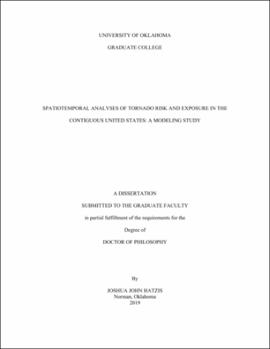| dc.contributor.advisor | Koch, Jennifer | |
| dc.contributor.author | Hatzis, Joshua | |
| dc.date.accessioned | 2019-10-16T13:19:06Z | |
| dc.date.available | 2019-10-16T13:19:06Z | |
| dc.date.issued | 2019 | |
| dc.identifier.uri | https://hdl.handle.net/11244/321496 | |
| dc.description.abstract | Tornadoes represent a significant threat to both life and property across the United States. It is unclear exactly how climate change may influence the occurrence and intensity of small-scale phenomenon (below the resolution of current climate models), such as tornadoes. However, changes have already been observed in the spatial and temporal variability of tornadoes. Regardless of whether climate change results in substantial changes in tornado frequency or severity, continued population growth and the expansion of urban areas will likely lead to an increasing amount of exposure of people and buildings to tornadoes. Potential future changes in tornado risk and exposure require new methods for studying tornado impacts through simulation. This dissertation discusses the development and application of a new tornado impacts model, the Tornado Daily Impacts Simulator (TorDIS). First, we conducted a spatiotemporal analysis of near-miss violent tornadoes as a justification for the use of spatial models in tornado impact analysis. Second, we discussed the development of TorDIS and showcased its utility via comparisons of annual tornado exposures between six metropolitan areas. We also show an example of using TorDIS to assess potential tornado impacts on individual high-risk days. Finally, we describe a case study, using TorDIS, over the Oklahoma City Metropolitan Area of the combined and isolated effects of climate change and urban development on tornado impacts. Models such as TorDIS can be used by emergency managers to pre-allocate resources to the areas of greatest risk/potential impact, by city planners to assess how changes in land use could affect the potential tornado risk and impacts, and as a justification for the placement of public storm shelters in the areas of highest potential tornado risk and impacts. | en_US |
| dc.language | en_US | en_US |
| dc.subject | tornado risk | en_US |
| dc.subject | spatial model | en_US |
| dc.subject | urban development | en_US |
| dc.subject | climate change | en_US |
| dc.title | Spatiotemporal Analyses of Tornado Risk and Exposure in the Contiguous United States: A Modeling Study | en_US |
| dc.contributor.committeeMember | Brooks, Harold | |
| dc.contributor.committeeMember | Neeson, Thomas | |
| dc.contributor.committeeMember | Martin, Elinor | |
| dc.contributor.committeeMember | Shafer, Mark | |
| dc.date.manuscript | 2019-10-15 | |
| dc.thesis.degree | Ph.D. | en_US |
| ou.group | College of Atmospheric and Geographic Sciences::Department of Geography and Environmental Sustainability | en_US |
| shareok.orcid | https://orcid.org/0000-0002-8291-6551 | en_US |
